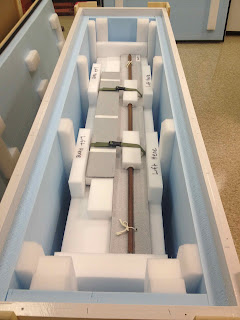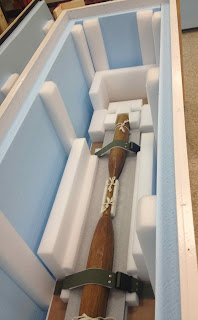By Gwen Spicer
Any time an artifact travels, there is a great deal of risk. However, travel they must. Especially since part of the mission for a museum is education and displaying the artifacts to the public, and sometimes the public is far away, perhaps even on another continent. Such is the case with collections from several New York State institutions that are traveling to Germany for the exhibit: On the Trail of the Iroquois, to open in Bonn, Germany later this year. This is an opportunity for a broader audience to see these amazing artifacts.
Spicer Art Conservation has been fortunate to be part of this great exhibition. Several former posts have discussed some of the artifacts that are included in this exhibit. But this particular post is less about the content of the exhibit, and more about the logistics of getting rare, unique and exceptionally delicate artifacts packed up, put on an airplane, and ultimately delivered to the other side of the world. And then of course displayed before being packed up and flown back home.
The important part of such an endeavor is for all of the artifacts to safely arrive and then return. That is where the experience of Professional Art Packers and craters come into place.
First the individual artifacts need to be carefully supported. Then they and their supports need to be boxed and placed into sturdy creates. It is a mathematical and geometrical problem that needs to be worked out in three-dimensions. It also must be performed so that all the parts can be easily understood. Standard systems have been worked out over the years by specialized Art Packing companies. However, since each artifact is so individual, there is also a lot of custom work that is necessary.
Below are a few examples of such packing techniques that were designed by professional art packers.
One type of packing is called cavity packing. It consists of foam that is carved slightly larger than the size of the artifact, the cavity is lined with polyester batting and covered with a layer of soft Tyvek. The foam fills the inside of a box, and several boxes fill a create. The individual artifacts are arranged to fit a specific area.
 |
| The small artifacts were kept in place with small pillows attached to twill tape. |
 |
| Cavity packing of a larger artifact. |
Larger three dimensional artifacts are boxed. Below are several stages of a support for a basket. The box is made of Gatorboard. Both the base that the basket sits upon, and the support mid-way up, slide out.
 |
| Basket being fitted. |
 |
| Internal support for the basket. |
Below is the inside of a box for a ceramic pot. The pot is secured and surrounded with the same materials and methods as Cavity packing.
 |
| The pots rests on a cushion and is secured with two halves that surround the neck of the pot. The front sides pulls out, using the tabs. The pot can be safely removed. |
The smaller boxes fit inside of this create. The larger box is for the basket and the two smaller boxes are for two ceramic pots.
 |
| Create with the boxes installed. |
 |
| The vertical box behind is only to fill the space. |
As you can begin to see, the artifacts are grouped by their needs, shapes and sizes. For this group of artifacts, size was a determining factor, as well as weight. One long crate was created for all of the long artifacts that included javelins, arrows, and a pestle. The storage trays for each of these artifacts were incorporated into the packing. Some additional supports were added. The heaviest item, in this case the pestle, was positioned as the bottom tray. The vertical Ethafoam sides of the tray supported the tray to be placed on top.
| Detail of buckle support. |
 |
| The Cane and Blow gun. |
Another crate was sized for two larger artifacts, one being an overdress. Other mid-sized artifacts were groups to fill additional trays.
 |
| The Ethafoam frame work is incorporated in the design to support the upper trays when placed in the crate. |
 |
| Individual bumpers were secured to the underside of the straps that secured the mounted Snowshoes. |
 |
| Straps were not used with this artifact, instead an Ethafoam beam was used to provided overall gentle pressure. |
 |
| A Volara layer was secured to outer surfaces of the Ethafoam bumpers. |
Archival packing and crating is a geometric three-dimensional puzzle. The individual packing occurs on site, but before the professional art packers arrive, there is extensive work that is done first. A full plan is mapped out where all of the artifacts are to go. Each tray and the amount of space is predetermined and pre-cut Ethafoam pieces are provided that are pre-sized.
It is critical that an institution provides as many accurate dimensions as possible. The dimensions must include not just the standard, height and width, but also depth. If storage trays or other supports are present, these too need to be disclosed. No company that is being asked to perform this task can know the size of these, and communicating as much as possible is necessary.
So many steps exist prior to an exhibit opening. The orchestration of borrowing artifacts from several institutions, and then conserving, conditioning and packing these artifacts will be for nothing if they are not transported with the utmost care by the experts.
_____________________________Gwen Spicer is a textile conservator in private practice. Spicer Art Conservation specializes in textile conservation, object conservation, and the conservation of works on paper. Gwen's innovative treatment and mounting of flags and textiles is unrivaled. To contact her, please visit her website.


You're spot on. Extra care must be given for handling these artifacts, so that they don't end up getting damaged while being transported. This is of the utmost importance, and it's great that you don't take this for granted. With your work, more people will still have access to these historic works and artifacts for years to come. Thanks for sharing!
ReplyDeleteThelma Bowman @ Quality Strapping